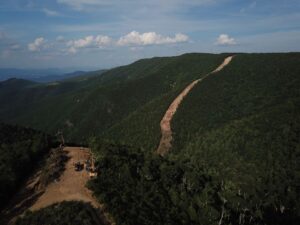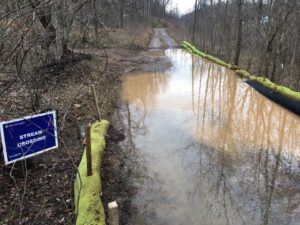We just spent Earth Day in the midst of the global COVID-19 pandemic, and people are wondering what the “new normal” looks like by questioning what type of work is considered “essential.”

Near my house in Kingston, NY, for instance, road construction has ramped up now that there’s less traffic. But what other types of construction are continuing during the nationwide shutdown? Apparently, state governments view pipeline construction as essential, as pipeline employees are currently maintaining and monitoring construction sites in several states in accordance with social distancing guidelines.
These states’ decision that pipeline workers are essential reflects their belief that natural gas is a key component of the current energy mix. But at what cost?
Natural gas pipelines are dangerous, destructive, and disruptive ways of producing and moving energy. These pipelines are notorious for spotty oversight and a lack of transparency by utilities and regulators, prone to leaks and spills, and primary causes of natural gas fires and explosions.
As the U.S. continues to support the fossil fuel industry, however, environmental organizations and communities also continue fighting back. Nonviolent direct action protestors, in particular, have been fighting against pipelines for decades.
The Mountain Valley Pipeline Impacts Communities and the Environment

The Mountain Valley Pipeline (MVP) project in Appalachia is one powerful example of how pipelines ravage the forest, fields, waterways, and communities on both federal and private land. This natural gas pipeline system is projected to span approximately 303 miles from northwestern West Virginia to southern Virginia, with plans to extend south into North Carolina. Regulated by the Federal Energy Regulatory Commission (FERC), the MVP is constructed and owned by Mountain Valley Pipeline, LLC.
The high-pressure pipeline will carry natural gas from shale fields in West Virginia to markets on the East Coast. Its path cuts through private lands, protected natural areas, crosses over 1,000 water source locations, and across the Appalachian Trail (AT). The 42-inch pipeline will run parallel to the AT for 15 miles and be visible, on and off, for 90 miles of the Trail.
On June 23, 2017, the FERC released its final environmental impact statement on the MVP, determining that “construction and operation of the projects would result in limited adverse environmental impacts, with the exception of impacts on forest.” In August of 2019, conservation groups launched a lawsuit against the U.S. Fish and Wildlife Service’s (USFW) approval of the MVP on behalf of the serious threats to endangered species. Currently, the pipeline is in violation of the Endangered Species Act and is missing multiple permits needed for stream crossings.

Since 2017, the steep mountainsides near Roanoke have been carved up for the MVP. Heavy rains that start in the spring and continue through the summer wash sediment from construction areas into nearby streams, disrupting sensitive wildlife habitats and posing a threat to drinking water supplies.
Previous DEQ inspections of the pipeline construction determined substantial adverse impacts to water quality and that the “MVP has failed to construct and maintain erosion and sediment control or pollution prevention measure in accordance with approved site-specific plans”.
Support for the pipeline, however, is strong and enforced through police. Multiple people have been charged in relation to nonviolent direct actions against the MVP.
Stand (or Sit-In) Against the MVP
However, local communities, regardless of political identities, object to the MVP. Even Tea Party Republicans on the Board of Supervisors in Craig County, Virginia, have united with environmentalists against the pipeline.
April 19th marked the 593rd day that protestors have occupied tree stands about 50 feet off the ground in a white pine and chestnut oak grove near Elliston, Virginia. This camp, known as Yellow Finch, is the longest ongoing blockade of the MVP. On March 12, 2020, the Yellow Finch blockade publicly announced its third tree-sit, inviting others to come and check it out in solidarity against the pipeline.
Individuals involved in the sit-ins say it feels powerful to be able to stop immediate construction for a day.

And the protests are getting results. The MVP, proposed to be in service by 2018, has been delayed to late 2020 due to multiple legal setbacks and mandatory reviews, but also because of the physical blockade from protestors.
If one person can stop construction for a day, imagine what could be accomplished if more of us stood up (or sat in a tree) to defend the places we love. Could the MVP be further delayed if the media lifts up the stories of protestors to create transparency around the status of the project? Is there potential that the MVP won’t receive the necessary permits to complete the pipeline?
People Fighting Pipelines
The fight against natural gas pipelines is worldwide and often organized by vulnerable communities. We know the names of popular environmental organizations that oppose pipelines in court (Sierra Club, Green Peace, Center for Biological Diversity, Friends of the Earth), but we rarely get to know individuals standing up (or, in this case, sitting) for the environment and their communities.
Let this global pandemic create space for a reenvisioned society; the health of our air, waters, soils, forests, and communities should take precedence over fossil fuel company profits. Let us observe Earth Day every day.
I invite you to ask yourself: What does it look like to stop a pipeline? Stand with direct action protestors—their actions, along with those of environmental organizations, are necessary for the push back against pipelines.
All photos are from Appalachian Against Pipelines. Please consider donating to help them continue fighting: bit.ly/supportmvpresistance
